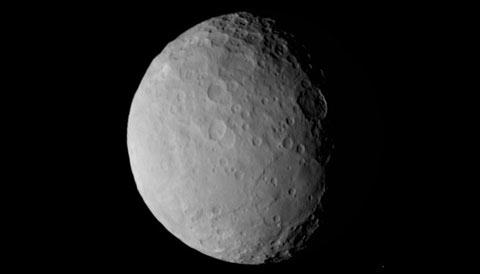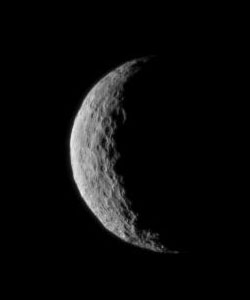The long-distance traveler has finally arrived at the first dwarf planet (and largest asteroid) yet studied by spacecraft.
If the best things in life are worth waiting for, then it's been totally worth it for the team of scientists and engineers involved in NASA's Dawn mission. After a 7½-year journey that covered 3.1 billion miles (4.9 billion km), the spacecraft has finally settled into orbit around its second and final destination: the giant asteroid 1 Ceres.

NASA / JPL-Caltech / UCLA / MPS / DLR / IDA
The orbital capture occurred today at 4:39 a.m. Pacific Standard Time (12:39 Universal Time), with the spacecraft about 38,000 miles (61,000 km) from Ceres and out of contact with Earth.
Mission flight controllers at NASA's Jet Propulsion Laboratory received telemetry from Dawn about an hour later, confirming that the spacecraft was healthy and its ion thruster firing as planned. This thruster, which expels a steady stream of xenon ions at roughly 25 miles per second, has provided the gentle, continuous thrust that propelled Dawn first to asteroid 4 Vesta and now to Ceres. (Here's a fun video showing how the engine operates.)
This is a relatively small spacecraft, roughly the size of a golf cart, with a mass of 1,647 pounds (747 kg). At launch it was packed with an additional 937 pounds (425 kg) of xenon for its thruster — that's not much fuel, considering that since leaving Earth the spacecraft's velocity has been throttled up and down by a cumulative 24,000 miles per hour. The thruster is powered by a pair of huge solar-cell panels that stretch some 60 feet (nearly 20 m) across.

NASA / JPL / UCLA / MPS / DLR / IDA
Although Dawn has been recording images of Ceres for weeks, some of which show provocative features, the real science at Ceres won't begin for a while. The thruster will lower and circularize the initial orbit until, next month, the spacecraft will start to characterize all of Ceres from an altitude of 8,400 miles (13,500 km). Then Dawn will be lowered to 920 miles (1,480 km) by August, where it remains in this high-altitude mapping orbit (HAMO) for two months. The spacecraft's German-built framing camera and Italian-built visible-infrared mapping spectrometer will be very busy during this phase of the mission.
Another long firing of the ion thruster will then nudge Dawn even closer, bottoming out at an altitude of about 230 miles (375 km) by no later than mid-December. From this low-altitude mapping orbit (LAMO), Dawn’s gamma-ray and neutron detector (GRaND) has a chance to map elemental abundances around the globe. Moreover, careful tracking of the spacecraft's motion should reveal subtle perturbations that are used to map the body's gravity field and internal structure. Scientists believe that Ceres consists of a rock-and-metal core surrounded by a thick mantle of water ice, with water constituting perhaps 25% of the body's mass.
In fact, planetary scientists expect that Ceres has much to teach them about the formation of the asteroid belt and the solar system in general. Ceres is a very different body than Vesta, Dawn's first target. For one thing, it's 590 miles (950 km) across — nearly twice Vesta's diameter and large enough to qualify as a dwarf planet. There's some suspicion that it never got warm enough to completely differentiate (separate) into discrete layers of rock and ice, but Ceres likely had some form of subsurface ocean early in its 4½-billion-year history.
"We have much to do over the next year and a half," notes principal investigator Chris Russell (UCLA) in a NASA press release, "but we are now on station with ample reserves, and a robust plan to obtain our science objectives."
Learn more about Dawn's objectives at Ceres in Emily Lakdawalla's extensive article in Sky & Telescope's April issue. Find it on your local newsstand or get the convenient digital edition.
 4
4









Comments
Graham-Wolf
March 6, 2015 at 8:40 pm
Congratulations NASA!
Ceres safely orbited, Pluto about to be closely flown past.... I'm getting rather impressed.
A huge acknowledgement to all those hard working scientists and engineers who have "made it happen". A huge effort from you all, that has remarkably paid off!
Keep up the fantastic work. We all need to be powerfully reminded what a precious and wonderful Universe, we all humbly live in.
Regards
Graham W. Wolf (Barber Grove Observatory), Lower Hutt, NZ
You must be logged in to post a comment.
March 7, 2015 at 6:15 am
My name ! How cool is that. Keep up the good work nasa...
You must be logged in to post a comment.
Jim-Baughman
March 13, 2015 at 5:01 pm
To NASA and all others who contributed expertise/equipment to this mission, well done! I have been watching excitedly as Ceres emerged from the fuzzy distance to the startlingly clear images we are seeing now. Can't wait to see the real close-ups and also read the analysis of the surface and possible sub-surface ocean.
Dear American Congress--stop starving space science programs of funds in order to give tax breaks to individuals/entities that don't need them.
You must be logged in to post a comment.
Kevin
March 14, 2015 at 1:49 pm
Congratulations to NASA/JPL! You folks accomplish some truly amazing things and give us armchair-astronauts remarkable views to ponder and a vicarious sense of adventure. Several hundred years from now a future version of NASA/JPL will see its interstellar probe arrive at the first exoplanet to see up close. Those future astronomers will have a lot of exoplanets to choose from!
You must be logged in to post a comment.
You must be logged in to post a comment.